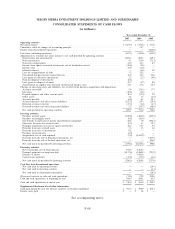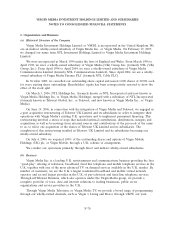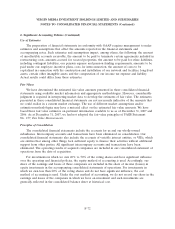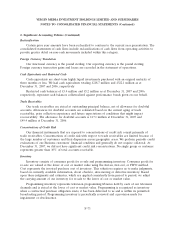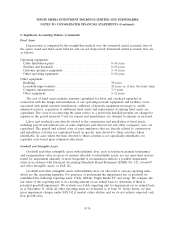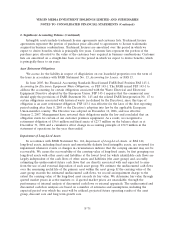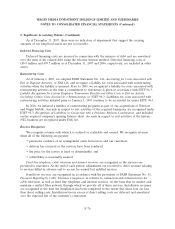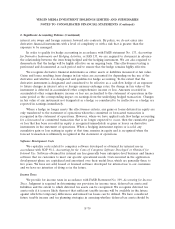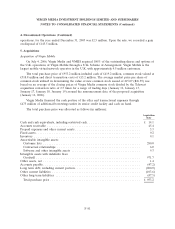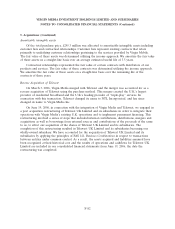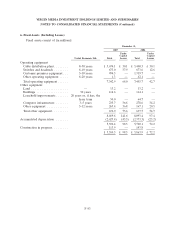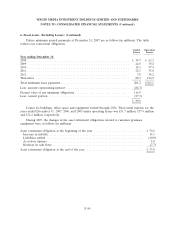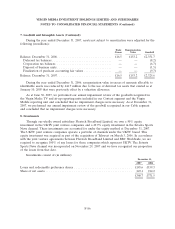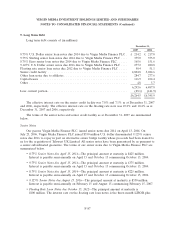Virgin Media 2007 Annual Report Download - page 164
Download and view the complete annual report
Please find page 164 of the 2007 Virgin Media annual report below. You can navigate through the pages in the report by either clicking on the pages listed below, or by using the keyword search tool below to find specific information within the annual report.VIRGIN MEDIA INVESTMENT HOLDINGS LIMITED AND SUBSIDIARIES
NOTES TO CONSOLIDATED FINANCIAL STATEMENTS (Continued)
2. Significant Accounting Policies (Continued)
FASB Statement No. 123, Accounting for Stock-Based Compensation, or FAS 123. On December 16,
2004, the FASB issued Statement No. 123 (revised 2004), Share Based Payment, or FAS 123R, which is
a revision of FAS 123. FAS 123R also supersedes APB 25 and amends FASB Statement No. 95,
Statement of Cash Flows, or FAS 95.
Virgin Media adopted FAS 123R on January 1, 2006 and elected to use the modified prospective
method, therefore, prior period results were not restated.
Stock-based compensation expense is recognized as a component of selling, general and
administrative expenses in the consolidated statement of operations.
Pensions
We account for our defined benefit pension plans using FASB Statement No. 87, Employer’s
Accounting for Pensions, or FAS 87, and the disclosure rules under FASB Statement No. 132 (revised),
Employers Disclosures about Pensions and Other Postretirement Benefits, an Amendment of FASB
Statements 87, 88 and 106, or FAS 132R. Under FAS 87, pension expense is recognized on an accrual
basis over employees’ approximate service periods. Pension expense calculated under FAS 87 is
generally independent of funding decisions or requirements.
In September 2006, the FASB issued Statement No. 158, Employers’ Accounting for Defined Benefit
Pension and Other Postretirement Plans—An Amendment of FASB No. 87, 88, 106 and 132(R), or
FAS 158. FAS 158 requires that the funded status of defined benefit postretirement plans be recognized
on a company’s balance sheet, and changes in the funded status be reflected in comprehensive income,
effective for fiscal years ending after December 15, 2006, which we adopted for the year ended
December 31, 2006. FAS 158 also requires companies to measure the funded status of the plan as of
the date of its fiscal year-end, effective for fiscal years ending after December 15, 2008. The impact of
adopting the recognition provisions of FAS 158 as of December 31, 2006 was an increase in liabilities of
£9.4 million and a pre-tax increase in the accumulated other comprehensive loss of £9.4 million.
Derivative Financial Instruments
We are exposed to various market risks, including changes in foreign currency exchange rates and
interest rates. As certain portions of our indebtedness accrue interest at variable rates, we are exposed
to volatility in future cash flows and earnings associated with variable interest rate payments. Also,
substantially all of our revenue and operating costs are earned and paid in pounds sterling and, to a
lesser extent, U.S. dollars and euros, but we pay interest and principal obligations on some of our
indebtedness in U.S. dollars and euros. As a result, we have exposure to volatility in future cash flows
and earnings associated with changes in foreign currency exchange rates on payments of principal and
interest on a portion of our indebtedness. We are also exposed to volatility in future cash flows and
earnings associated with foreign currency payments in relation to operating costs incurred in the normal
course of business.
Our objective in managing our exposure to fluctuations in interest rates and foreign currency
exchange rates is to decrease the volatility of our earnings and cash flows caused by changes in
underlying rates. To achieve this objective, we have entered into derivative financial instruments. We
have established policies and procedures to govern the strategic management of these exposures
through a variety of derivative financial instruments, including interest rate swaps, cross-currency
F-78


